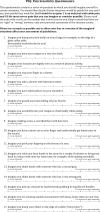Understanding Ocular Discomfort and Dryness Using the Pain Sensitivity Questionnaire
- PMID: 27137908
- PMCID: PMC4854470
- DOI: 10.1371/journal.pone.0154753
Understanding Ocular Discomfort and Dryness Using the Pain Sensitivity Questionnaire
Abstract
Purpose: To utilize the Pain Sensitivity Questionnaire (PSQ) to assess the influence of pain sensitivity on perceptions of ocular discomfort and dryness.
Methods: Subjects completed a battery of questionnaires, including history of ocular and general health, contact lens wear history, the Ocular Surface Disease Index (OSDI) questionnaire, visual analog scale (VAS) 100-point rating scales to assess severity and frequency of average and end of day (EOD) discomfort and dryness, and the PSQ to assess pain sensitivity level. Masked subjects were then instructed to wear one inverted and one normally oriented soft contact lens contralaterally for 30 minutes to induce an inter-eye difference in comfort and dryness sensations. Subjects rated comfort and dryness in each eye on VAS every 5 minutes during contact lens wear. A slit lamp examination was performed to evaluate ocular surface health and to assess contact lens fit.
Results: One hundred and fifty-three subjects (111 females, 42 males) completed the study. In separate models, a higher PSQ score was significantly associated with higher OSDI score (p = 0.002), lower average and EOD comfort (p = 0.005 and 0.001, respectively), and greater EOD dryness (p = 0.04). The minimum (0.14) and maximum (7.14) PSQ scores observed in our subject cohort (i.e., from the subjects who were the least and most sensitive to pain, respectively) corresponded to an estimated difference of 11 points on the OSDI, 20 points on the VAS scale for average comfort, 31 points for EOD comfort and 17 points for EOD dryness. In a mixed effects model, a higher PSQ score was significantly associated with a greater inter-eye difference in comfort (p = 0.013) and dryness (p = 0.010) during CL wear.
Conclusions: Pain sensitivity influences perceptions of ocular discomfort and dryness, and should be taken into account when evaluating subjective assessments of these symptoms.
Conflict of interest statement
Figures
Similar articles
-
End-of-day dryness, corneal sensitivity and blink rate in contact lens wearers.Cont Lens Anterior Eye. 2015 Jun;38(3):148-51. doi: 10.1016/j.clae.2015.01.003. Epub 2015 Jan 30. Cont Lens Anterior Eye. 2015. PMID: 25649692
-
Ocular discomfort responses after short periods of contact lens wear.Optom Vis Sci. 2015 Jun;92(6):665-70. doi: 10.1097/OPX.0000000000000607. Optom Vis Sci. 2015. PMID: 26001894 Clinical Trial.
-
Diurnal Variation in Comfort in Contact Lens and Non-contact Lens Wearers.Optom Vis Sci. 2016 Aug;93(8):820-7. doi: 10.1097/OPX.0000000000000920. Optom Vis Sci. 2016. PMID: 27362615
-
An Amplifying Cascade of Contact Lens-Related End-of-Day Hyperaemia and Dryness Symptoms.Curr Eye Res. 2018 Jul;43(7):839-847. doi: 10.1080/02713683.2018.1457163. Epub 2018 Apr 9. Curr Eye Res. 2018. PMID: 29630423 Review.
-
Does the level of available oxygen impact comfort in contact lens wear?: A review of the literature.Eye Contact Lens. 2007 May;33(3):148-55. doi: 10.1097/01.icl.0000245572.66698.b1. Eye Contact Lens. 2007. PMID: 17502750 Review.
Cited by
-
Evaluation of Ocular Irritation Sensitivity: Implications of Clinical Parameters, Pain Sensitivity, and Tear Neuromediator Profiles.J Clin Med. 2024 Dec 29;14(1):138. doi: 10.3390/jcm14010138. J Clin Med. 2024. PMID: 39797220 Free PMC article.
-
Translation, Cross-Cultural Adaptation, and Validation of the Pain Sensitivity Questionnaire in Dutch Healthy Volunteers.Pain Res Manag. 2020 Jul 23;2020:1050935. doi: 10.1155/2020/1050935. eCollection 2020. Pain Res Manag. 2020. PMID: 32774564 Free PMC article.
-
Ocular Neuropathic Pain: An Overview Focusing on Ocular Surface Pains.Clin Ophthalmol. 2020 Sep 25;14:2843-2854. doi: 10.2147/OPTH.S262060. eCollection 2020. Clin Ophthalmol. 2020. PMID: 33061269 Free PMC article. Review.
-
Evidence that Dry Eye Represents a Chronic Overlapping Pain Condition.Mol Pain. 2017 Jan-Dec;13:1744806917729306. doi: 10.1177/1744806917729306. Mol Pain. 2017. PMID: 28814146 Free PMC article. Review.
-
Validation of the Turkish version of the Pain Sensitivity Questionnaire in patients with chronic pain.J Int Med Res. 2021 Dec;49(12):3000605211060158. doi: 10.1177/03000605211060158. J Int Med Res. 2021. PMID: 34855531 Free PMC article.
References
-
- Fillingim RB. Individual differences in pain responses. Curr Rheumatol Rep. 2005. September;7(5):342–7. - PubMed
-
- Gatchel RJ, Peng YB, Peters ML, Fuchs PN, Turk DC. The biopsychosocial approach to chronic pain: scientific advances and future directions. Psychol Bull. 2007. July;133(4):581–624. - PubMed
Publication types
MeSH terms
Grants and funding
LinkOut - more resources
Full Text Sources
Other Literature Sources
Medical



